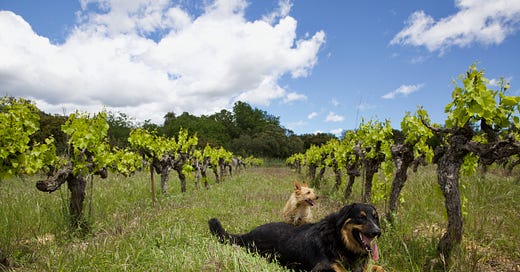Issue 4: The Avant Gard
In the Gard, where the Rhône meets the Languedoc and Provence, a new wave of innovative natural vignerons emerges - rewriting the playbook for southern red varieties.

It’s Issue 4 of the Not Drinking Poison newsletter! A landslide of stories from the Gard, a French départment whose wines always get divided haphazardly between the Rhône and the Languedoc on wine lists. A closer look reveals a unique Gardois wine identity, based upon its terroir and its culture, which by turns resemble those of the southern Rhône, the Languedoc, and Provence.
Within natural wine circles, the Gard is also known as a key waypoint in the spread of natural winemaking throughout the south of France.1 As Tavel’s Eric Pfifferling puts it, inside the issue: “We arrived like a second wave, after all the work that Marcel Lapierre, Jean Foillard, Ptit Max, and all did. Now there’s a third generation arriving.”
And the wines are fascinating. In the past seven years the region’s new wave has embraced the inclusion of large proportions of direct-press juice in red winemaking, yielding bright, vivid wines that bely the region’s heat and transmit the salinity of its copious limestone and sandy clays. Some, like Ad Vinum and Les Frères Soulier, are pushing stylistic boundaries much further.
I made three trips through the Gard this spring, interviewing vignerons and trying to get a feel for its curious, hybrid landscape.
In the south, the Gard borders the Camargue marshlands and touches the Mediterranean; there, as around the touristic town of Uzès at its center, the region takes on a Provençal flavour. In the east, bordering the Rhône, parts of the Gard are within the Côtes-du-Rhône appellation, and show a kinship with the mistral-buffeted right bank in the Vaucluse. As one travels west in the Gard, the mistral drops off, and one enters a ridged, Languedocienne landscape where the garrigue is sheltered by the Cevennes mountains range.
The vignerons in this issue are mostly clustered between Uzès and Tavel in the east of the department. But the Gard is home to many more talented natural vignerons. I hope to include a few more in an addendum to this issue later in July.
In the meantime, here’s a deep dive into to THE AVANT GARD:
An oral history of Eric and Marie Pfifferling’s legendary TAVEL estate DOMAINE DE L’ANGLORE.
A profile of former LE CHÂTEAUBRIAND sommelier turned winemaker SEBASTIEN CHATILLON a.k.a. AD VINUM, an unpredictable vinificateur now taking root as a vigneron in Vallabrix.
A very long apéro with Saint-Quentin-la-Pôterie vigneron VALENTIN VALLÈS, the erstwhile Pfifferling protégé who has since cast his own long shadow within the Gard natural wine scene.
An interview with CHARLES SOULIER of LES FRERES SOULIER, a restless and visionary young vigneron in Saint-Hilaire-d’Ozilhan.
A profile of LA FERME DU CADE’s DAVID TEYSSIER, a former cooperateur now embracing a polycultural approach to farming and natural winemaking in Saint-Laurent-de-Carnols.
Lunch at chef DIDIER BENOIT’s excellent bistrot LA TÊTE D’AIL in Saint-Hilaire-d’Ozilhan. (No paywall.)
Lunch in Valliguières with DOMAINE DU PETIT ORATOIRE’s LORI HAON, who’s practicing radical natural vinification at an impressive scale.
A tour of Rochefort du Gard’s mosaic of terroirs with NICOLAS RENAUD of CLOS DES GRILLONS, the only avowed L’Anglore acolyte to regularly hit similar heights.
An article on QUENTIN LE CLEAC’H, the artisan DISTILLER who has made the Gard his home since 2017, and whose alembic still has seen the (failed) wines of the region’s greatest natural vignerons. (No paywall.)
A stroll in the vineyards of Saint-Victor-la-Coste with the singular LOLITA SÈNE, novelist turned natural vigneron-négoçiant.
A tasting with newly-installed Sanilhac polycultural farmer and vigneron-négoçiant THOMAS BOUET of LES MAGESSES, who works side by side in viticulture with Sébastien Chatillon.
Many thanks for reading, as always! Here’s to sunshine, and fine beads of effervescence in young wine.
In a nutshell: Thierry Puzelat’s close friend and schoolmate Jean-François Nicq settled in the Gard in 1989, taking charge of the Cave des Vignerons d’Estézargues. Throughout the following decade, influenced by his friend Puzelat (who in turn was influenced by Marcel Lapierre), Nicq set about convincing the cooperateurs to convert to organics, and gradually began vinifying the coop’s production along natural principles. Before he left to found his own estate in the Roussillon in 2001, Nicq also convinced a cooperateur friend in the neighboring village of Tavel to begin making wine. The friend was Eric Pfifferling of Domaine de l’Anglore. In 2004, Nicq and the Pfifferlings, aided by friends like Ardèche vignerons Gérald Oustric and Gilles Azzoni, would found the influential tasting salon La Remise, which helped unite the nascent natural wine scene of the south of France.


